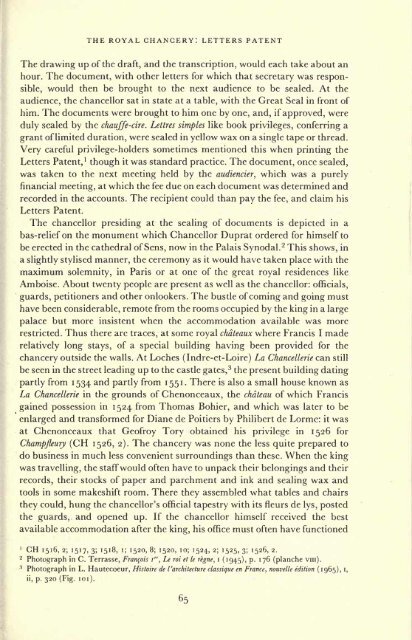Untitled - Monoskop
Untitled - Monoskop
Untitled - Monoskop
You also want an ePaper? Increase the reach of your titles
YUMPU automatically turns print PDFs into web optimized ePapers that Google loves.
THE ROYAL CHANCERY: LETTERS PATENT<br />
The drawing up of the draft, and the transcription, would each take about an<br />
hour. The document, with other letters for which that secretary was responsible,<br />
would then be brought to the next audience to be sealed. At the<br />
audience, the chancellor sat in state at a table, with the Great Seal in front of<br />
him. The documents were brought to him one by one, and, if approved, were<br />
duly sealed by the chauffe-cire. Lettres simples like book privileges, conferring a<br />
grant of limited duration, were sealed in yellow wax on a single tape or thread.<br />
Very careful privilege-holders sometimes mentioned this when printing the<br />
Letters Patent, 1<br />
though it was standard practice. The document, once sealed,<br />
was taken to the next meeting held by the audiencier, which was a purely<br />
financial meeting, at which the fee due on each document was determined and<br />
recorded in the accounts. The recipient could than pay the fee, and claim his<br />
Letters Patent.<br />
The chancellor presiding at the sealing of documents is depicted in a<br />
bas-relief on the monument which Chancellor Duprat ordered for himself to<br />
be erected in the cathedral of Sens, now in the Palais Synodal. 2 This shows, in<br />
a slightly stylised manner, the ceremony as it would have taken place with the<br />
maximum solemnity, in Paris or at one of the great royal residences like<br />
Amboise. About twenty people are present as well as the chancellor: officials,<br />
guards, petitioners and other onlookers. The bustle of coming and going must<br />
have been considerable, remote from the rooms occupied by the king in a large<br />
palace but more insistent when the accommodation available was more<br />
restricted. Thus there are traces, at some royal chateaux where Francis I made<br />
relatively long stays, of a special building having been provided<br />
for the<br />
chancery outside the walls. At Loches (Indre-et-Loire) La Chancellerie can still<br />
3<br />
be seen in the street leading up to the castle gates, the present building dating<br />
partly from 1534 and partly from 1551. There is also a small house known as<br />
La Chancellerie in the grounds of Chenonceaux, the chateau of which Francis<br />
gained possession in 1524 from Thomas Bohier, and which was later to be<br />
enlarged and transformed for Diane de Poitiers by Philibert de Lorme: it was<br />
at Chenonceaux that Geofroy Tory obtained his privilege in 1526 for<br />
Champfleury (CH 1526, 2). The chancery was none the less quite prepared to<br />
do business in much less convenient surroundings than these. When the king<br />
was travelling, the staff would often have to unpack their belongings and their<br />
records, their stocks of paper and parchment and ink and sealing wax and<br />
tools in some makeshift room. There they assembled what tables and chairs<br />
they could, hung the chancellor's official tapestry with its fleurs de lys, posted<br />
the guards,, and opened up. If the chancellor himself received the best<br />
available accommodation after the king, his office must often have functioned<br />
1 CH<br />
2<br />
1516, 2; 1517, 3; 1518, i; 1520, 8; 1520, 10; 1524, 2; 1525, 3; 1526, 2.<br />
Photograph in C. Terrasse, Francois i" Le roi et le i<br />
', regne, (1945), p. 176 (planche vm).<br />
:<<br />
Photograph in L. Hautecoeur, Histoire de I'architecture classique en France, nouvelle edition (1965), i,<br />
ii, p. 320 (Fig. 101).<br />
65

















